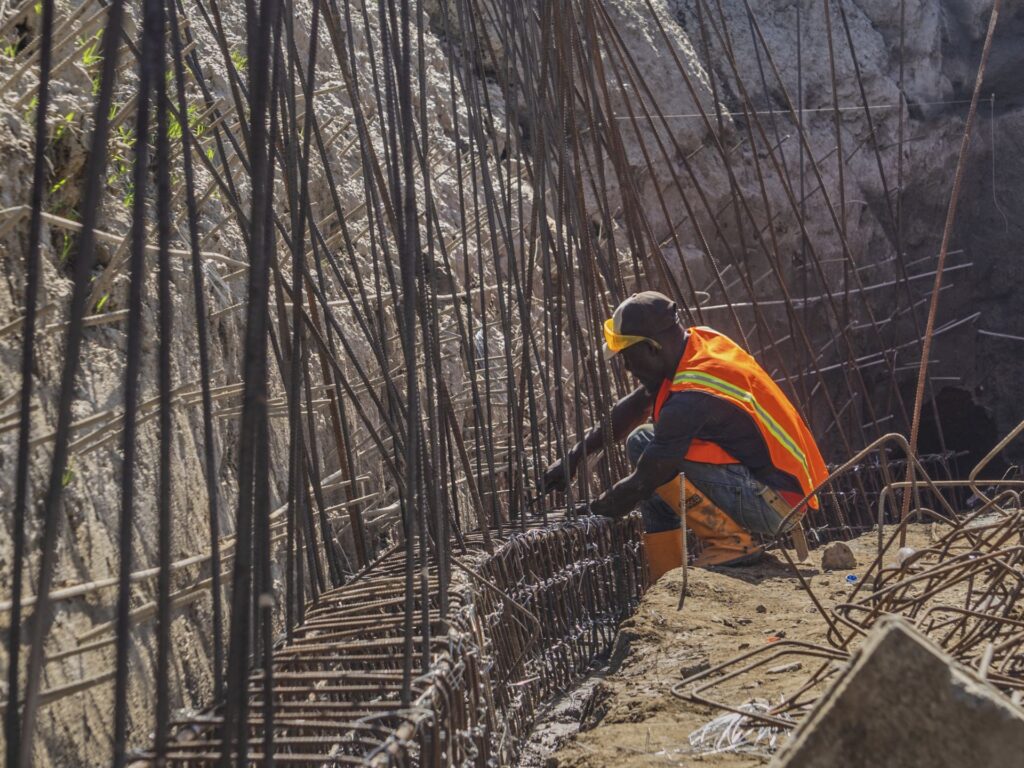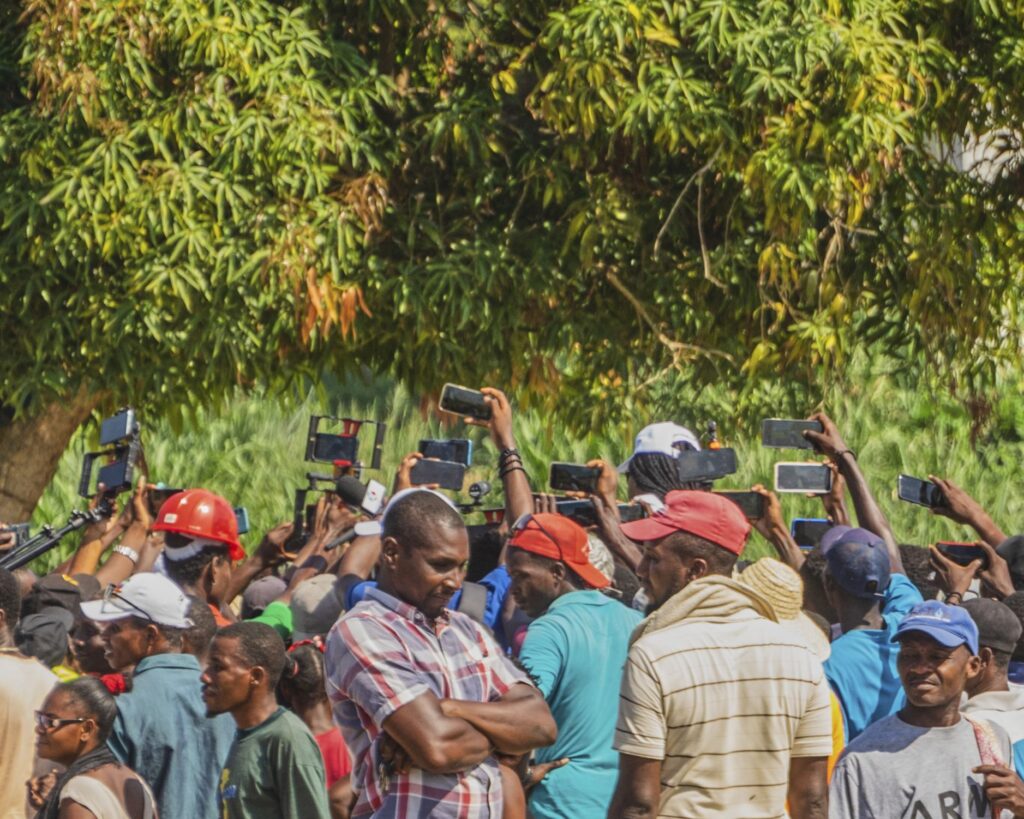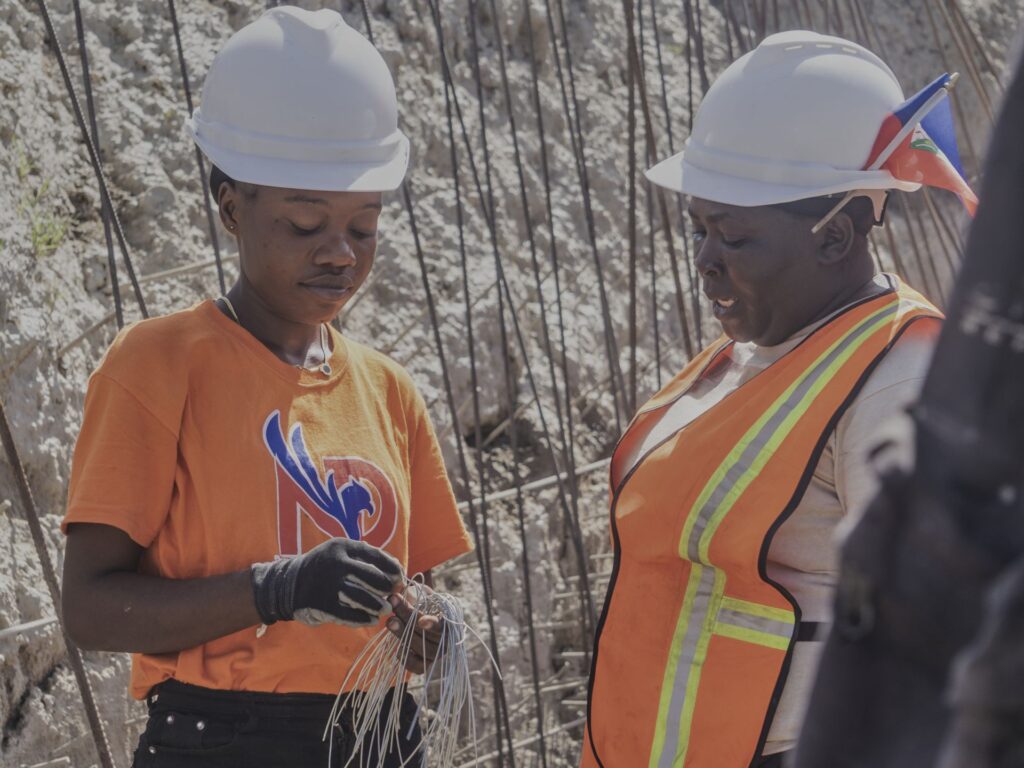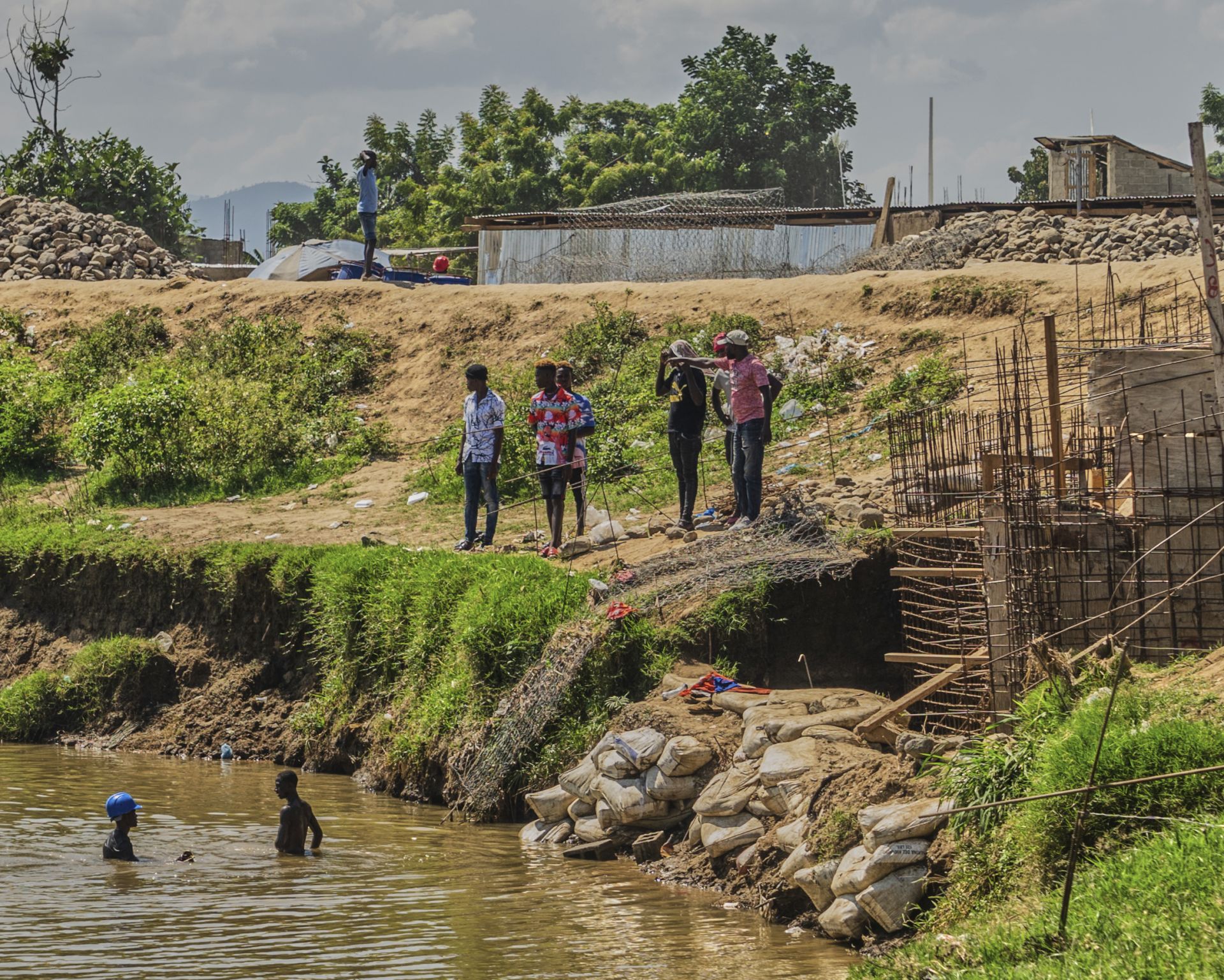On a recent afternoon, tension at the river shared between Haiti and the Dominican Republic was palpable. Armed Haitian officers sat under a mango tree while Dominican soldiers were alert and on guard about 25 yards away.
Both sides were focused on keeping the peace as construction proceeded on an irrigation canal that is at the heart of a diplomatic standoff. Haitians see the canal as a matter of food autonomy and national sovereignty, but their Dominican neighbors say the canal will divert water away from their land. The highly controversial canal is the latest chapter in the two Caribbean countries’ long, complicated and often strained relationship, which is largely drawn along racial lines and reflects the countries’ different experiences of independence. The Dominican Republic is significantly richer than its neighbor, and frequently sends economic migrants back home across the border when diplomatic tensions are high.
Near the town of Ouanaminthe, in Haiti’s northeast, a few hundred volunteer builders are hard at work, laying thin steel pipes for the canal. Measuring just over 1.5 miles long and about 1 yard wide, it is set to facilitate the watering of more than 7,000 acres of fertile land covering the entire Maribaroux plain. Paid using donations from private backers, some of the workers wear colorful hard hats and fluorescent vests, while others toil in jeans and T-shirts. The canal is very much a collective effort for Haitians, who have mobilized around a viral hashtag in Haitian Creole: #KPK, KANAL LA PAP KANPE — the canal construction will not stop.
But it will stop if the Dominican Republic has its way. Just over a month ago, Dominican President Luis Abinader unilaterally closed the entire border between the two countries, hoping that a blockade on Haitian migrants and businesses would force a halt to construction. The canal would divert water from the Massacre River, violating a 1929 treaty between the two countries, according to Abinader, who says the water supply to thousands of Dominican families would be restricted. Haitian experts and officials deny this claim and argue that high-level negotiations between the countries two years ago allowed for the canal’s construction. Haiti further maintains that the 1929 treaty gives it a right to build the canal, since it details how this shared natural resource should be managed.
The Dominican Republic has repeatedly drawn water from the river, having created aqueducts, dams and five irrigation canals of its own.

The disputed canal is Haiti’s first attempt to get water from the Massacre River, named after the murder of French buccaneers by Spanish settlers in 1728. The island was unified under Haitian leadership between 1822 and 1844, in what was viewed by Dominicans as an annexation. Dominican military dictator Rafael Trujillo, who rose to power a century later, referred to this period as an occupation, cultivating the idea that the ongoing “Haitianization” of the Dominican Republic needed to end; in 1937 he ordered another massacre at the river, this time to force Haitians back over the porous border.
Both Haiti and the Dominican Republic, which share the island of Hispaniola, were occupied by the United States, beginning in the 1910s. Over the course of Haiti’s post-independence struggles, Haitians have fled to neighboring countries, a large number choosing to migrate to the Dominican Republic. Recent decades have been marked by Haitians and Dominicans of Haitian descent experiencing human rights abuses and unequal treatment in the Dominican labor force, including arbitrary detention and being forcibly removed to Haiti.
President Abinader’s policies have been stoking anti-Haitian sentiments and using the weakness of the Haitian government to establish Dominican “hydrohegemony” on the island, where the two countries have similar population sizes of around 11 million each.
“In general, Dominican leaders tend to lay down the law without our say and dictate the rules without our say. The current context is generating the awakening of Haitians who certainly understand the issues. Haitians are taking advantage of this to force our neighbors to act with fairness,” said Dr. Maismy Fleurant, a Haitian expert in international law and Vice Dean of Research at Universite Publique du Nord-Est in Fort-Liberte.
Last year, Haitians closed the border at Ouanaminthe for about a week to protest human rights abuses that Haitian migrants were experiencing at the hands of Dominican border agents. These include racial profiling, to the degree that the U.S. government issued a statement to warn dark-skinned Americans of risks when traveling to the Dominican Republic. Then, as now, the border closure galvanized discussion in Haiti about investing in local food production and buying goods locally.
For years, Haiti has been in disarray. According to the U.N., around 80% of its capital, Port-au-Prince, is under the influence of gangs, and international organizations have described the city as being gripped by constant fear. The gangs coerce children as young as 10 into their ranks, and sexual violence against women is being used to terrorize the population. In early October, the U.N. agreed to send a multinational force to Haiti in an attempt to quell the violence.
That explains why, for Haiti, this is about more than just a canal; it is about a country’s right to exploit its own resources. The construction site has become a source of nationalistic pride. Even if the government could stop the canal diggers, it has not shown a desire to do so.
Artists, religious leaders, political leaders, unions, diaspora groups and ordinary Haitians have donated over $10,000 for construction materials, provided food for canal builders, organized fundraisers and made in-kind donations, including cement and equipment. Many average citizens, politicians and celebrities have visited the construction site. On Sunday evenings, crowds gather to enjoy live music from popular musicians such as Pay Kawot, a street band based in Cap-Haitien, about 40 miles to the northwest.
“We are challenging the real enemies of Haiti, those who, after more than 200 years, have done nothing really to help Haiti get out of this rut,” said Josaphat Guillaume, a Haitian farmer and leader of a rural workers’ organization in Ferrier called KPSKBN (Kodinasyon Plante Seksyon Kominal Ba Maribawou) in Haitian Creole, which translates as “Coordination of Planters of the Communal Section of Bas-Maribaroux.”
Founded in 1996, KPSKBN is one of the organizations at the helm of the canal’s construction. “The construction of the canal irrigation on the Massacre River and Haitian solidarity testify to the desire of an entire nation to say no to foreign interference and to fight to regain its former dignity and pride,” Guillaume told New Lines.

Given the prevalence of hunger in the country — the country was recently ranked 161st of 191 countries by the United Nations Human Development Index — addressing food insecurity is an urgent priority for the Haitian people. Haitian farmers are forced to compete in a market flooded by inexpensive Dominican and American imports that have squashed local agricultural efforts for decades. In 2010, former President Bill Clinton apologized for his administration’s trade policies toward Haiti, which imposed low tariffs and subsidized U.S. rice exports, essentially destroying Haitian food autonomy. “It may have been good for some of my farmers in Arkansas, but it has not worked. It was a mistake,” Clinton said at the time.
There is enormous agricultural potential in Haiti, with many square miles of cultivable yet historically neglected land. The Haitian towns of Ferrier and Ouanaminthe stand to benefit most from the new canal and could become the breadbasket of Haiti. Haiti’s agriculture sector comprises a quarter of the economy’s GDP and half of all employment, according to the World Bank. Still, many challenges make market access difficult for Haitian farmers. In addition to competition from cheap imports, Haiti’s farmers lack access to credit, and without government investment in irrigation systems, even modest economic development eludes them.
The canal is widely seen as a panacea for such ills. “It will improve the yield of our crops in the plain. Our lands will be better watered. Our living conditions will certainly change. We will produce and cultivate much more food,” said Guillaume.

After a month of border closure and the loss of an estimated $21 million by Dominican businesses, Abinader, who is up for reelection, decided to reopen the border with Haiti, but only for commerce. Even Haitians with Dominican visas are not allowed into the country. In response, Haitians in Ouanaminthe have kept their side of the border closed.
“The reopening of the Haitian-Dominican border by the Dominican government will not change anything. On the contrary, it will strengthen us further,” said Wideline Pierre, an architect and acting spokesperson for the committee managing the canal’s construction. “We demand respect for the rights of Haitians and the fair and equitable application of treaties and agreements signed between the two countries.”
Haitian volunteers building the canal lack the necessary technical expertise, according to Abinader. But Haitians argue otherwise, saying a committee of engineers and technicians is carefully overseeing construction, ensuring safe conditions for the workers, and managing donations.
Planning for the canal started almost 10 years ago during the administration of Haiti’s President Michel Joseph Martelly. But construction stopped with the assassination of President Jovenel Moise on July 7, 2021. Soon after, Prime Minister Ariel Henry came to power due to pressure from the so-called CORE group, including ambassadors from the U.S., EU, Germany, Brazil, Canada, Spain and France, and representatives of the Organization of American States (OAS) and the U.N. So far, Henry has failed to organize elections due to his lack of legitimacy and inability to address the security crisis.
Finally, after weeks of ignoring the farmer-led effort calling for construction to resume, Henry suddenly appeared assertive. During his speech at the United Nations General Assembly in September, he affirmed Haiti’s right to water from the river, according to the 1929 treaty with the Dominican Republic. A few days later, while attending a meeting organized by OAS, the Haitian Ambassador Leon Charles declared that construction on the canal would continue.
Haitian farmers believe that the canal they are building symbolizes their future, a glimmer of hope, the recovery of their sovereignty, their dignity and their food autonomy. The construction is expected to end in early 2024, and the determination of many in Haiti is clear, as they call for massive investments in the agricultural sector, particularly in the Maribaroux Plain, in an effort to put an end to Haiti’s food dependence on its neighbor.
This story was produced with support from the Round Earth Media Program of the International Women’s Media Foundation in partnership with Woy Magazine.
“Spotlight” is a newsletter about underreported cultural trends and news from around the world, emailed to subscribers twice a week. Sign up here.



